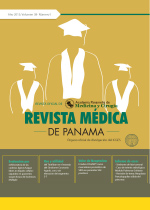Síndrome de la Persona Rígida
Autores/as
DOI:
https://doi.org/10.37980/im.journal.rmdp.2015357Resumen
Síndrome de la Persona Rígida
Stiff-Person Syndrome
Resumen
El Síndrome de la Persona Rígida (SPR), también conocido como Tétano Autoinmune, es una condición clínica poco frecuente en la cual se ven afectados tanto la musculatura agonista como la antagonista de miembros superiores e inferiores y la columna cérvico-torácica. Afecta más a mujeres que a hombres. Los síntomas aparecen entre la segunda a quinta década de la vida y pueden ser desencadenados por niveles altos de estrés tanto emocional como físico. Su fisiopatología permanece aún sin entenderse completamente, pero se ha demostrado la relación con la presencia de anticuerpos anti glutamato descarboxilasa y sus variantes GAD65 y GAD67 con esta enfermedad. Los primeros síntomas se presentan de forma trivial como rigidez nucal, cefalea y contracturas musculares y de no ser tratado a tiempo puede llevar al paciente a un opistótonos, comprometiendo los músculos de la ventilación y por ende poniendo en riesgo la vida del paciente. Este es el primer caso de SPR hasta donde es de nuestro conocimiento, con anticuerpo anti-glutamato descarboxilasa positivo en Panamá.
Abstract
Stiff Person Syndrome (SPS), also known as Autoimmune Tetanus, is a rare condition, which affects both, agonist and antagonist muscle groups of the upper and lower limbs and the cervical-thoracic spine. SPS affects both genders but is more frequent in women; symptoms appear between 20-50’s, triggered by emotional and physical stress. Its pathophysiology remains uncertain, but a relation between antibodies against glutamate acid decarboxylase, and its two variants GAD65 and GAD67 serum levels and manifestation of the disease has been shown. Symptoms appear in a casual form of cervicalgia with cervical rigidity, headaches, and muscle spasms that can evolve into opistotonus therefore compromising ventilatory muscles becoming a life-threatening situation. To our knowledge, this is the first case of SPS in Panama with a positive glutamate acid decarboxylase antibody.
Palabras claves: Persona Rígida, anticuerpo anti-GAD, contractura muscular.
Key words: Stiff-Person, anti-GAD antibody, muscle spasm.
Publicado
Número
Sección
Licencia
Derechos autoriales y de reproducibilidad. La Revista Médica de Panama es un ente académico, sin fines de lucro, que forma parte de la Academia Panameña de Medicina y Cirugía. Sus publicaciones son de tipo acceso gratuito de su contenido para uso individual y académico, sin restricción. Los derechos autoriales de cada artículo son retenidos por sus autores. Al Publicar en la Revista, el autor otorga Licencia permanente, exclusiva, e irrevocable a la Sociedad para la edición del manuscrito, y otorga a la empresa editorial, Infomedic International Licencia de uso de distribución, indexación y comercial exclusiva, permanente e irrevocable de su contenido y para la generación de productos y servicios derivados del mismo. En caso que el autor obtenga la licencia CC BY, el artículo y sus derivados son de libre acceso y distribución.










